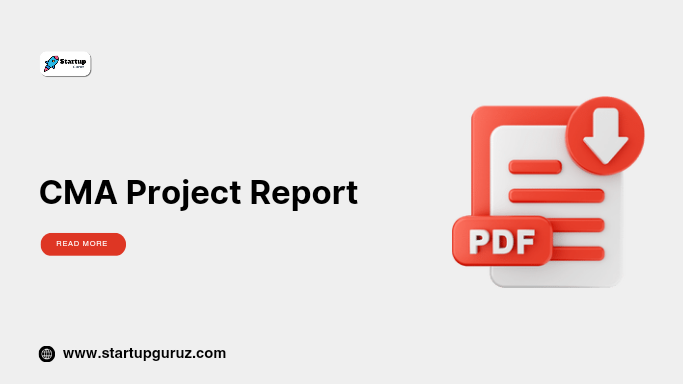CMA Project Report
CMA Project Report: Comprehensive Guide
A Credit Monitoring Arrangement (CMA) project report is a vital document for businesses seeking loans from banks and financial institutions. It provides a detailed analysis of a company’s financial health, operational efficiency, and projected growth. Banks use CMA reports to evaluate the borrower’s ability to repay the loan and assess the risks involved.
This guide provides an in-depth understanding of how to prepare a CMA project report, its components, benefits, and the role it plays in securing loans.

What is a CMA Project Report?
A CMA project report is a financial document that outlines the borrower’s financial history, present condition, and future projections. It is primarily used by banks to monitor credit limits and evaluate loan applications. It includes details such as cash flow statements, projected revenue, profit margins, and financial ratios.
Why is a CMA Project Report Important?
- Loan Approval: A well-prepared CMA report increases the chances of loan approval.
- Transparency: It provides a clear picture of the company’s financial health.
- Risk Assessment: Helps banks assess the risks associated with lending.
- Strategic Planning: Aids businesses in planning finances effectively.
Components of a CMA Project Report
1. Basic Details of the Business
- Name and address of the business.
- Nature of business (manufacturing, trading, service, etc.).
- Year of establishment.
- Promoters and key management details.
2. Existing Financial Statements
- Balance sheet for the past two to three years.
- Profit and loss statements.
- Cash flow statements.
3. Operating Cycle Analysis
- Details of the working capital cycle, including inventory turnover and accounts receivable/payable periods.
4. Projected Financial Statements
- Projected balance sheet for the next 3-5 years.
- Estimated profit and loss statements.
- Future cash flow forecasts.
5. Fund Flow Statements
- Overview of fund inflow and outflow.
- Sources and uses of funds.
6. Ratio Analysis
- Financial ratios, including debt-to-equity, current ratio, and net profit margin.
- Highlights financial strengths and areas for improvement.
7. Loan Utilization Plan
- Purpose of the loan.
- Breakdown of how the borrowed funds will be used.
8. Assumptions for Projections
- Basis for revenue growth.
- Expense management strategies.
- Market conditions and industry trends.
Steps to Prepare a CMA Project Report
1. Understand the Purpose
Identify the loan type and the bank’s specific requirements.
2. Gather Financial Data
Compile historical and current financial statements.
3. Analyze Financial Performance
Evaluate profitability, liquidity, and solvency.
4. Prepare Projections
Forecast future financial performance based on realistic assumptions.
5. Include Supporting Documents
Attach necessary documents such as tax returns, licenses, and agreements.
6. Review and Finalize
Ensure accuracy and clarity before submitting the report to the bank.
Benefits of a CMA Project Report
- Secures Bank Loans: Demonstrates financial capability and growth potential.
- Improves Credibility: Enhances the business’s reputation with lenders.
- Aids Financial Management: Identifies strengths and weaknesses in financial operations.
- Regulatory Compliance: Ensures adherence to banking norms and guidelines.
Common Mistakes to Avoid
- Inaccurate Data: Ensure all financial figures are accurate and up-to-date.
- Unrealistic Projections: Avoid overestimating revenue or underestimating expenses.
- Incomplete Information: Include all required components and supporting documents.
- Lack of Professionalism: Maintain a professional and concise tone.
FAQs
1. What is a CMA project report?
A CMA project report is a financial document used by banks to evaluate a business’s loan eligibility and repayment capacity.
2. Why is a CMA report required?
It helps banks assess the borrower’s financial health, operational efficiency, and ability to repay the loan.
3. What are the key components of a CMA report?
Key components include financial statements, projected cash flows, fund flow statements, ratio analysis, and loan utilization plans.
4. How do I prepare a CMA report?
Collect financial data, analyze performance, prepare projections, and include supporting documents such as tax returns and licenses.
5. Is a CMA report mandatory for all loans?
It is typically required for loans exceeding ₹2 crore under the Credit Monitoring Arrangement.
6. How accurate should the projections in a CMA report be?
Projections should be realistic and based on credible assumptions to ensure accuracy and reliability.
7. What role does ratio analysis play in a CMA report?
Ratio analysis highlights the financial strengths and weaknesses of a business, aiding in risk assessment.
8. Can small businesses prepare a CMA report?
Yes, small businesses can prepare a CMA report with the help of financial consultants or tools.
9. What mistakes should I avoid while preparing a CMA report?
Avoid providing inaccurate data, unrealistic projections, and incomplete information.
10. Can I revise a CMA report?
Yes, revisions can be made to address errors or incorporate updated financial data.
Conclusion
A CMA project report is an essential tool for businesses seeking loans from banks. It provides a detailed financial analysis, helping lenders evaluate the borrower’s creditworthiness and repayment capacity. By understanding the components, benefits, and preparation steps, businesses can create a professional and effective CMA report.
Investing time and effort into preparing a comprehensive CMA report not only increases the chances of loan approval but also strengthens the financial planning and management of the business.